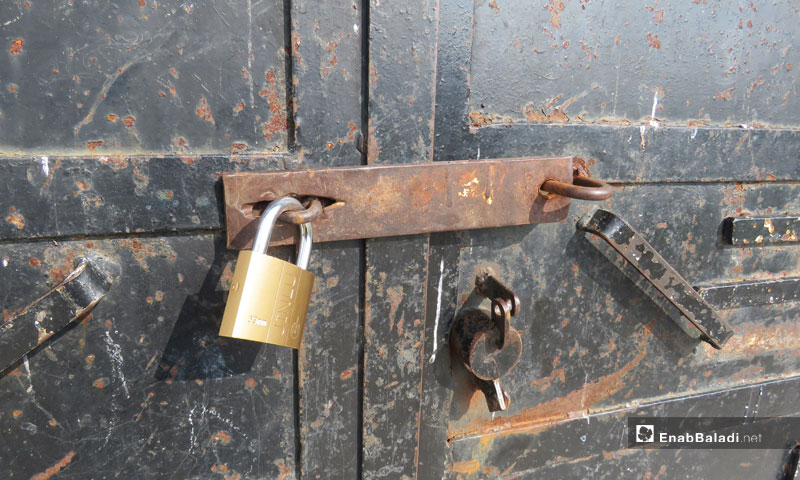



The photos of the Hass city’s school massacre, committed in November 2016, in which more than 20 children were killed by thermobaric missiles, are still present in the memory of the villages of Idlib and Hama’s people, prompting them to refuse to send their children to schools, which, for the past two months, became a target for the shells and the missiles of the Assad’s forces and the militias backing them.
Since the beginning of February, the Syrian regime has intensified its shelling of the villages and towns of Idlib and Hama in the “demilitarized zone.” Thousands of civilians have been displaced from their homes and most schools have been closed for fear of students getting harmed.
Under the military operations in northern Syria, the education sector is facing many difficulties and challenges, some can be overcome and others are beyond the control of the educational staff, such as the safety of students during the education process, while it is worth mentioning that many students have dropped out with the break out of the shelling campaign that is targeting the area.
Fayhaa al-Shawash, a teacher from southern Idlib, told Enab Baladi about the reasons why some students are dropping out of school. She said that the Syrian regime’s shelling of rural Idlib triggered a reaction among students: fear of death or injury. It is enough for the child to hear a plane to involuntary flee the school.
Al-Shawash added that a large percentage of the schools were targeted directly by the regime, including the school in which they were operating in the town of Hass, southern rural Idlib, where they were targeted with high-explosive rockets and the victims were mostly children and teachers.
According to Mustafa Haj Ali, the media official of Idlib’s Education Directorate, the rate of the children dropping out of schools in Idlib governorate, northern Syria, reached 35%, speaking of elementary school, including grades 1 to 4, 25%, when it comes to the middle school, covering grades 5 to 9, and the third and nearly largest rate, almost 60%, was recorded in high school. He added that all these rates are alarming.
Al-Haj Ali told Enab Baladi that the number of schools recently closed has reached 45, and 15,000 students have been denied access to education because of the displacement of people from hot zones, including the town of Jarjnaz, al-Tah, Khan Shaykhun and the neighboring towns and those in eastern Idlib.
A report, released by the Response Coordinators team last January, indicated that the number of Syrian children who dropped out from schools in northern Syria is 1.7 million children between the ages of 5 and 17, while another 1.3 million children are at risk of dropping out due to the forced displacement and the urge to escape threatened areas.
As for the destruction that befell the schools in Idlib, the same report indicated that only 60 schools were affected so far, while the team continues to document the material casualties.
The conditions of the educational process in rural Idlib are similar to those in the northern and western areas of Hama, which are also under continuous bombardment by the Assad’s forces, though the Sochi deal, signed by Turkey and Russia in September 2018, is yet in force.
Mufeed Shaiban, from the village of Tremseh, rural Hama, fled to southern rural Idlib and lives in Bloudan Farm Camp. He, having six children, the eldest of them is in the middle school, is concerned over their future, especially when it comes to school and their ability to resume education.
He spoke to Enab Baladi about the long distance that his sons have to walk to reach their schools on a daily basis, in addition to the indiscriminate shelling of the area, which has an impact on their psychology and is triggering in them a fear of going to school as not to be threatened with death.
The Free Hama Directorate of Education has suspended the educational process since the start of the bombing campaign. Hussein Hashem, an official of the directorate, informed Enab Baladi that 6,000 students have been deprived of their schools because of the conditions in the area, for more than 35 schools have been closed, in different areas starting with Qalaat al-Madiq and reaching the village of Zayzoun.
Hashim said that the Free Hama Directorate of Education covers several educational compounds most of which were shelled, which led to a full suspension of all school activities, especially in the northern and western rural parts of the governorate, the villages of al-Ghab Plain and Shashabo Mountain.
Earlier on, the United Nations Children’s Fund (UNICEF) warned that the lives of more than one million Syrian children in the province of Idlib are threatened.
The organization added that three of the facilities it funds in Idlib were under military attack, noting that two of them provided relief to children and women and were completely out of service because of the destruction that befell them.
if you think the article contain wrong information or you have additional details Send Correction